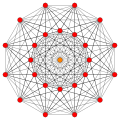Top Qs
Timeline
Chat
Perspective
2 51 honeycomb
Eight-dimensional geometric tessellation From Wikipedia, the free encyclopedia
Remove ads
In 8-dimensional geometry, the 251 honeycomb is a space-filling uniform tessellation. It is composed of 241 polytope and 8-simplex facets arranged in an 8-demicube vertex figure. It is the final figure in the 2k1 family.
This article includes a list of references, related reading, or external links, but its sources remain unclear because it lacks inline citations. (July 2025) |
Remove ads
Construction
It is created by a Wythoff construction upon a set of 9 hyperplane mirrors in 8-dimensional space.
The facet information can be extracted from its Coxeter-Dynkin diagram.
Removing the node on the short branch leaves the 8-simplex.
Removing the node on the end of the 5-length branch leaves the 241.
The vertex figure is determined by removing the ringed node and ringing the neighboring node. This makes the 8-demicube, 151.
The edge figure is the vertex figure of the vertex figure. This makes the rectified 7-simplex, 051.
Remove ads
Related polytopes and honeycombs
Remove ads
References
- Coxeter The Beauty of Geometry: Twelve Essays, Dover Publications, 1999, ISBN 978-0-486-40919-1, (Chapter 3: Wythoff's Construction for Uniform Polytopes)
- Coxeter Regular Polytopes (1963), Macmillan Company
- Regular Polytopes, Third edition, (1973), Dover edition, ISBN 0-486-61480-8, (Chapter 5: The Kaleidoscope)
- Kaleidoscopes: Selected Writings of H.S.M. Coxeter, edited by F. Arthur Sherk, Peter McMullen, Anthony C. Thompson, Asia Ivic Weiss, Wiley-Interscience Publication, 1995, wiley.com, ISBN 978-0-471-01003-6
- (Paper 24) H.S.M. Coxeter, Regular and Semi-Regular Polytopes III, [Math. Zeit. 200 (1988) 3–45]
Remove ads
Wikiwand - on
Seamless Wikipedia browsing. On steroids.
Remove ads
 ...
...






 ,
,  ...
...



